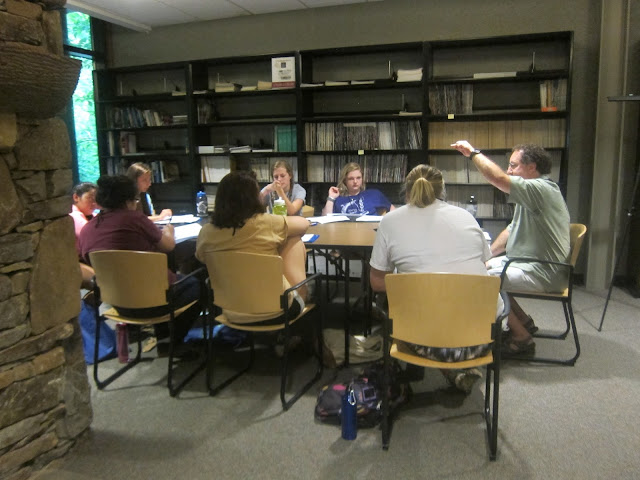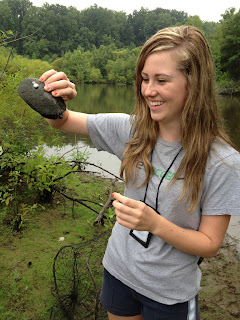Focus Groups
Redesigning Our Future Focus Groups
Focus groups at the Summit allow students to immerse themselves in a particular subject area and discover how their talents and passions can contribute to environmental causes. Students will choose a focus group after being accepted into the program. These are sample group topics. Sessions may change from year to year.
Alien invasive species are considered one of the top threats to biodiversity on the planet. First this focus group intends to provide an introduction to the value of organismal biodiversity, from ecosystem services to the intrinsic value provided by diverse communities of plants and animals. Then we will discuss and learn (in the field) about how invasive organisms arrive in new habitats and the negative impacts invasive species may have on native biodiversity. However, the positive impacts in terms of ecosystem services (e.g. Asiatic clams filtering the water column, Kudzu serving as forage for endangered butterflies) of invasive species will also be underscored because in some environments, such as urban parks, invasive species are ubiquitous and are here to stay. We will use Kudzu (and/or Chinese Wisteria) and Asiatic Clams in the Catawba Ecological Preserve as model organisms, and more than half of the session will be spent in the preserve, quantifying the magnitude of the invasions using field sampling techniques and work to identify potential solutions or recommendations to control or use invasive species productively (as in eating Kudzu!).
Read more about Dr. Jay Bolin.
2018 Focus Groups
A Backbone for Conservation
Instructor: Joe Poston
Vertebrates, animals with backbones, come in all shapes and sizes, and they include animals that are active at all times of day and all times of year. This variety of behavior makes it challenging to study vertebrates in the wild. In addition, many vertebrates are endangered because of human actions. Consequently, it is even more important to study wild vertebrate populations to help us make decisions about how to improve their chances of surviving. In this module, you will learn some of the techniques that scientists use to study populations of vertebrates in the wild. We will study animals that are active during the day and animals that are active at night. If you have a sense of adventure, and a willingness to get dirty, then you have a backbone for conservation.
Environmental Health Investigators
Instructor: Carmony L. Hartwig
Environmental health is an important and rapidly growing field that intertwines several aspects of science including ecology, biology, chemistry and bioengineering. The overall health of an environment can be assessed by investigating the invertebrate diversity and abundance in a given area, and can provide important information as to the health of the surrounding ecosystem. In this focus group we will discuss the basic biology of select invertebrate species, as well as learn the techniques associated with collection and surveillance measures that investigators employ in the field. We will discuss the benefits of invertebrates to the overall health of an ecosystem, as well as how climate change may affect the diversity and abundance of these populations. We will spend most our time exploring the ecological preserve, and learn simple, hands-on ways we can influence invertebrate population dynamics in our community in the face of global environmental change. We will additionally spend a portion of our time in the laboratory, identifying collections and conducting molecular assays used by environmental health specialists.
Invasive Alien Plants and Animals: Friend or Foe to the Environment?
Instructor: Dr. Jay F. BolinAlien invasive species are considered one of the top threats to biodiversity on the planet. First this focus group intends to provide an introduction to the value of organismal biodiversity, from ecosystem services to the intrinsic value provided by diverse communities of plants and animals. Then we will discuss and learn (in the field) about how invasive organisms arrive in new habitats and the negative impacts invasive species may have on native biodiversity. However, the positive impacts in terms of ecosystem services (e.g. Asiatic clams filtering the water column, Kudzu serving as forage for endangered butterflies) of invasive species will also be underscored because in some environments, such as urban parks, invasive species are ubiquitous and are here to stay. We will use Kudzu (and/or Chinese Wisteria) and Asiatic Clams in the Catawba Ecological Preserve as model organisms, and more than half of the session will be spent in the preserve, quantifying the magnitude of the invasions using field sampling techniques and work to identify potential solutions or recommendations to control or use invasive species productively (as in eating Kudzu!).
Read more about Dr. Jay Bolin.
Puppy Love and Spider Eggs: Animal-Human Relations and Environmental Advocacy
Instructor: Dr. Kerstin Rudolph
Why do humans love and cherish certain animals, but slaughter, eat, or squash other species? Dogs and cats are our most common companion animals, and most of us agree that they play an important part in our lives, both socially and psychologically. We care for them, play with them, love them (and they love us back). We grieve with them and for them. Most of us also agree that these animals share more commonalities with us than differences, so maybe there are not that many boundaries between animals and humans after all? As a society, we accept an ethical and moral responsibility to advocate for certain animals’ rights, including the preservation of land/habitat and measures to protect against the extinction of species.
But when and why do such boundaries get blurrier? For example, when we apply them to livestock – do we love or eat our horses? Maybe both? What about exotic animals, fish, or insects? How much of a role does a person’s cultural background play in determining how high or low certain species rank on our human-animal bonding scale? Aside from giving us valuable insight into cultural and national differences, such attitudes inevitably have wide-ranging consequences. They shape and determine environmental policies on the national as well as international level.
In this workshop, we will ponder these and many other questions in an effort to understand debates about animal rights and environmental advocacy.
Adventures in Amphibian Research & Conservation
Instructor: Lisa Wear
In response to indications of worldwide declines in amphibian populations, the US Department of Interior initiated a national program of amphibian monitoring, research, and conservation. There is an urgent need to determine the scope and severity of problems associated with amphibian population declines, and to investigate causes. We will join the U.S. Geological Survey and ARMI (National Amphibian Research and Monitoring Initiative), to identify local environmental characteristics impacting North Carolina amphibian populations.
Student teams will investigative efforts to identify and implement effective and comprehensive strategies for the monitoring and conservation of amphibians in their natural habitats. Students will learn proper handling, research-based capture methods, safe physical restraint, evaluation, and release of amphibians in the field to include salamanders, frogs, toads, and newts.
A Visual Voice for the Environment
Instructor: Ashley Pierce
In this focus group, students can leverage their passion for art to change the world! We will discuss compositional techniques to engage the viewer as well as how to use painting to give a visual voice to environmental concepts. Each visual artwork will bring attention to a specific environmental concern. On completion of this focus group, students will have sharpened visual art skills along with a powerful resulting composition-a painting to take with them.


